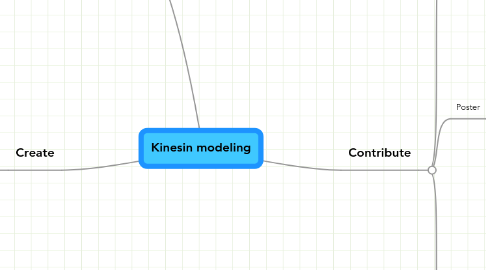
1. Contribute
1.1. Paper
1.1.1. we were thinking to make this paper more of a review of kinesin motility. Showing where all the rate constants came from. something like this
1.1.2. We can paste in most of the stuff from our previous paper writing...especially introduction
1.1.3. References
1.1.3.1. Definite references
1.1.3.1.1. Larry has a bunch already
1.1.3.1.2. Probably need to find more prior modeling papers, especially by Fisher
1.1.3.2. Possible refs
1.1.3.2.1. Endow spindle modeling paper
1.2. Poster
1.2.1. Poster will be done before paper
1.2.2. Want to have literature very solid for talking with people at poster
1.2.3. Conclusions for poster
1.2.3.1. Code will be available
1.2.3.2. Osmotic Pressure slows down velocity
1.2.3.3. Certain states are blah blah blah
1.3. Place code in public; usable
1.3.1. Place code in public; usable
1.3.1.1. Code must be relatively clean but doesn't have to be too clean
1.3.1.1.1. As an example, The cleaning that Larry did for the tracking subVI helped a bunch and is sufficient
1.3.1.2. Compiled version will require a license to run
1.3.1.2.1. Can talk with Malloy to see if his brother (brother in law) can get us some special NI deal so people can run our code for free? Perhaps a license that expires?
1.3.1.2.2. Virtual machine possiblity (Deepak advice at #scio10)
1.3.1.2.3. Also possibility of remotely logging in to our own server
1.3.1.3. Data posted on IR?
1.3.1.3.1. Test data (real and simulated)
1.3.1.4. Create screen cast to demonstrate how to use
1.3.1.4.1. Storyboarding would help
1.3.1.5. Code to Possibly Make Pulbic
1.3.1.5.1. Kinesin simulator
1.3.1.5.2. Rate constant viewer
2. Whiteboard
2.1. Images
2.2. 16 states for a head (Agent)
2.3. Multiple rate constants (3 or 4)
2.4. Some are modified by other agent (only if strain)
2.5. 128 states combined
2.5.1. 16 states for one head
2.5.1.1. pi only is not a state
2.5.1.2. This counts front / back
2.5.2. 16x16 is 256
2.5.2.1. But one head has to be behind the other
2.6. Two state energy diagram
2.6.1. Picture
2.7. Table
2.7.1. This was some way to write the rate constants down, perhaps
3. Create
3.1. Code
3.1.1. Changes to rate constants
3.1.1.1. Analyze strain through a lens of two state energy diagram. Double check that the constants make sense
3.1.1.2. Make a sub.vi that allows for easy change to certain rate constants
3.1.1.2.1. right now the user has to look at the code and make changes to the global variables but we want to give the user an interface to change this
3.1.1.2.2. Steve thinks we can do something clever to make rate constants easy to view / edit
3.1.1.3. Search any recent papers for new revelations
3.1.2. Add in references to where all the constants came from
3.1.3. We were thinking that the inorganic phosphate release may be slow because the state it enters is a state with strain. We were looking at Guydosh/Block paper
